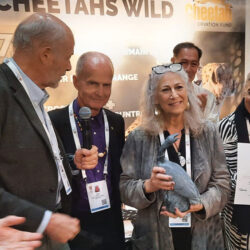After 30-Year Civil War, Cheetah Presence in Angola Confirmed
-

- by CCF Staff March 16, 2010
For Immediate Release
After 30-Year Civil War, Cheetah Presence in Angola Confirmed
(Otjiwarongo, Namibia , 16 March 2010) – Dr. Laurie Marker, Executive Director of the Cheetah Conservation Fund, an international research based organization based in Namibia, confirmed the existence of cheetah in Angola last week during a three-day survey conducted in Iona National Park, located in the Namibe province. This arid area in the extreme southwest of the country was one of the former ranges of the cheetah; however, due to Angola’s three-decade civil war, the cheetah’s status in the country has been unknown.
The 1.6 million hectare lona National Park, proclaimed a reserve on 2 October 1937, is located in southwest Angola, bordering Namibia. Although it is very dry, the area is perfect cheetah habitat with thousands of hectares of open savannah and a growing prey base such as springbok and oryx, two species that adapt to an arid environment and are the cheetah’s primary prey. During the rapid survey, Marker used Global Positioning Systems (GPS) through the area, marking where game was found and recording the variety of habitats. “I probably saw a thousand springbok.” Marker stated. “Then, on the last day in the park, we were down by dry river beds where there are big trees that look like what we know in Namibia as “playtrees” or territorial marking areas usually used by male cheetahs. We found nine different marking trees, very similar to what we find in Namibia and in remote places like Algeria. I found cheetah scat in the tree. By one of the trees, two big male cheetahs ran out. It was very exciting – there are cheetahs in Angola.”
The rapid ecological survey, designed to assess the habitat and prey in the area as potential cheetah habitat, was carried out at the urging of Alvaro Baptista, owner of the Omauaha Lodge near Iona National Park in Namibe, who visited Marker in Namibia in 2006. Baptista informed Marker of cheetah sightings in the area and encouraged the undertaking of an extensive survey to confirm their presence and to help develop a conservation plan for their long-term protection and survival. According to Baptista, “This Park is not really functioning as a national park, as personnel and infrastructure are nonexistent at this point. However, visits to the area have recently been conducted by people from both the World Bank and the United Nations Development Programme.” Baptista has been active in the Namibe area his entire life and is considered one of the guardians of the Park. His Omauaha Lodge is one of the only tourism camps near the Iona Park.
Marker’s visit to Angola was endorsed by the Kissama Foundation (http://www.kissama.org), which has the mandate to support the development of the National Parks of Angola since peace came to the country in 2002. As a result of meetings in Angola’s capital, Luanda, Marker hopes to develop collaborations with Kissama, as well as universities and relevant government officials. The goal is to develop a program using CCF’s proven methods for censusing cheetah populations and assisting with community, government and non-government organizations in education awareness of cheetahs and bio-diversity to show the benefits of a predator’s role in a healthy ecosystem and ecotourism.
Editor’s notes:
The Cheetah Conservation Fund, celebrating 20 years in helping to save the wild cheetah, is a Namibian non-profit trust dedicated to the long-term survival of the cheetah and its ecosystems.
Since 1990, the organization has developed education and conservation programs based on its bio-medical cheetah research studies, published scientific research papers and has presented educational programs to more than 350,000 outreach school learners, donated over 300 livestock guarding dogs to commercial and communal farmers as part of the CCF innovative non-lethal livestock management program, and has established a cheetah genome resource bank of cheetah sperm, tissue and blood samples.
Research into cheetah biology and ecology has greatly increased our understanding of the fastest land animal and education programs for schools and the farming community help change public attitudes to allow predator and humans to co-exist. However, despite the many successes of CCF programs, the cheetah is still Africa’s most endangered big cat with ~10,000 cheetahs remaining.
“Playtrees” or marking trees have been found to be unique to cheetah territorial behavior in Namibia and other cheetah range countries. Cheetahs frequent these marking trees where they leave scat (faeces) as a scent marking for other cheetahs. In addition, cheetah females come to these marking trees when in oestrus.
Cheetahs have one of the largest home ranges recorded of mammals; in Namibia they average approximately 1,500 km2 and live at low densities.
Today’s world population of free-ranging cheetahs is estimated at 10,000 individuals, 25% of which are found in Namibia.
Related Reading


